Aquatic therapy offers unique benefits for Parkinson’s patients through water’s buoyancy, which reduces fall risk while enabling greater movement range. You’ll experience decreased muscle rigidity in warm water while improving balance, coordination, and strength. Group classes provide social connections that combat isolation and boost motivation. The supportive environment allows you to safely practice movements that transfer to daily activities on land. Discover how the pool environment can transform your management of Parkinson’s symptoms.
The Science Behind Aquatic Therapy for Parkinson’s
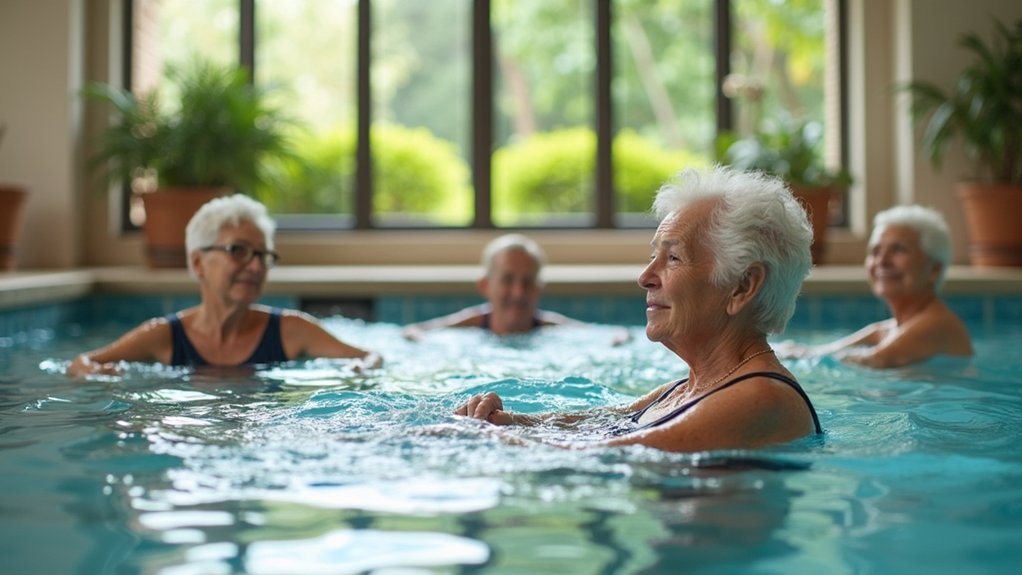
While traditional physical therapy offers numerous benefits for Parkinson’s patients, aquatic therapy provides a uniquely supportive environment that addresses multiple symptoms simultaneously.
The water’s buoyancy creates a safe space where you can exercise with minimal fall risk, reducing anxiety about movement.
Research shows aquatic therapy yields comparable results to land-based treatments for improving balance and mobility. The water environment stimulates your proprioception—your body’s position awareness—which is vital for coordination. Heated pool facilities provide warm water therapy that effectively relaxes tense muscles and reduces rigidity in patients.
Water therapy activates your body’s internal positioning system, enhancing coordination while delivering results equal to traditional exercises.
You’ll experience enhanced core muscle engagement, essential for stabilizing your posture.
Beyond physical benefits, water exercises trigger endorphin release, elevating your mood and reducing stress.
These sessions can improve cognitive function while delaying symptom progression. The warm water particularly helps decrease muscle rigidity and pain, making movement more comfortable.
Buoyancy Benefits: How Water Supports Movement Challenges
Buoyancy, the invisible force that counteracts gravity in water, transforms exercise possibilities for Parkinson’s patients. When you’re chest-deep in water, you’ll experience about 80% less gravitational force on your joints, making movements that feel impossible on land suddenly achievable.
You’ll notice this supportive environment allows for larger ranges of motion with considerably less effort. The warm water relaxes rigid muscles while simultaneously reducing your fear of falling. This combination creates a unique therapeutic space where your tremors may diminish and freezing episodes become less frequent. Water exercise offers a multisensory stimulation experience that engages tactile, visual, and auditory systems simultaneously.
Beyond physical benefits, you’ll likely experience a confidence boost as you regain movement control. Water’s gentle resistance strengthens your muscles without the need for weights, while its supportive nature improves your balance, coordination, and posture.
Getting Started: Essential Equipment for Pool-Based Therapy
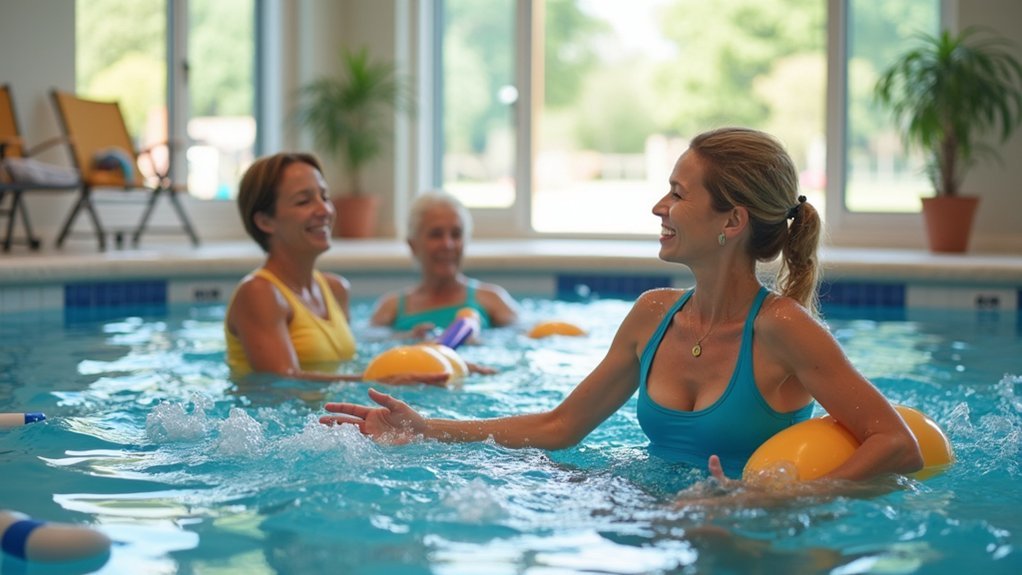
Before diving into pool-based therapy, you’ll need to gather the right equipment to guarantee safe, effective sessions. Start with basic mobility aids like pool steps, ramps, and handrails to ascertain you can enter and exit the water safely despite movement challenges.
Incorporate kickboards and flippers to support arm and leg exercises that build strength and flexibility. These tools are particularly helpful when working on maintaining range of motion affected by Parkinson’s symptoms.
Look for pools with adjustable depths, underwater treadmills, and resistance jets that can be customized to your physical capabilities. The water’s buoyancy reduces fear of falling while allowing for easier, larger movements during your therapy sessions.
Don’t forget about temperature—a properly heated pool reduces muscle tension and increases comfort during therapy sessions.
Finally, check if the facility offers underwater monitoring systems so therapists can properly guide your movements and track progress.
Warm Water Exercises to Reduce Rigidity and Tremors
Warm water creates an ideal therapeutic environment for Parkinson’s patients struggling with muscle rigidity and tremors. The heat soothes tense muscles while hydrostatic pressure enhances circulation, creating a dual therapeutic effect that can visibly reduce tremors during your session.
The healing embrace of warm water offers Parkinson’s patients a sanctuary where rigid muscles soften and trembling hands find momentary stillness.
Try gentle stretching exercises while submerged chest-deep. Extend your arms slowly in different directions, feeling the water’s resistance while your muscles relax in the warmth.
Trunk rotations and slow walking through water can greatly decrease rigidity in your core and legs. You’ll likely notice you can achieve a greater range of motion than on land. The buoyancy supports your body weight, allowing you to practice larger movements without fear of falling. Water exercise also promotes better posture as the natural properties of water encourage increased back extension while standing.
Many patients report temporary relief from tremors that sometimes extends beyond their time in the pool.
Balance and Coordination Training in the Aquatic Environment
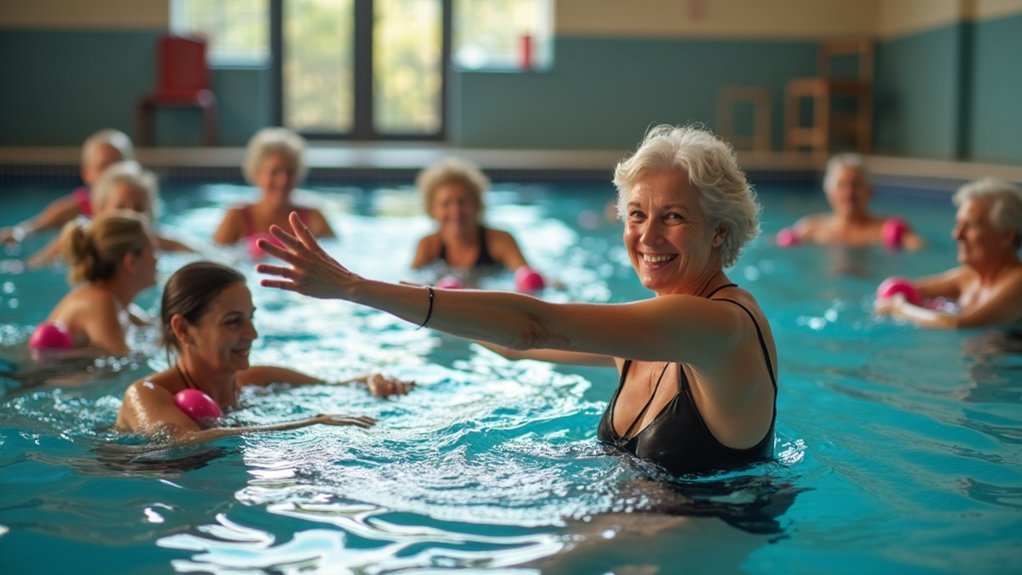
Balance and coordination exercises in water offer you powerful tools to combat Parkinson’s mobility challenges.
You’ll benefit from water-assisted balance techniques that provide supportive resistance while allowing safer practice of standing and walking movements.
The aquatic environment’s natural resistance creates opportunities for multidirectional training that enhances your proprioception and spatial awareness without the fear of falling. The buoyancy of water helps improve your posture while reducing stress on your joints during exercise.
Water-Assisted Balance Techniques
The unique properties of water create an ideal environment for Parkinson’s patients to practice balance exercises with reduced fall risk. Water’s buoyancy considerably decreases your effective body weight, providing natural support while you work on stability challenges.
You’ll benefit from dynamic exercises like weight shifting, reaching, and one-legged standing in this supportive medium. Using equipment such as swim bars or noodles can further enhance your confidence during these activities. The hydrostatic pressure surrounding your body provides gentle joint support while simultaneously improving circulation, enhancing your overall balance response.
Your therapist will progressively challenge your balance by introducing water turbulence or changing your base of support. These techniques aim to improve your posture, reduce fall risk, and increase functional independence.
As you practice these water-based exercises, you’ll develop skills that transfer to daily activities on land, helping maintain your mobility and quality of life.
Proprioception Through Resistance
Water resistance offers a unique advantage for Parkinson’s patients working on proprioception—your body’s awareness of its position in space. This resistance creates constant sensory feedback, enhancing your motor control and spatial awareness during movement. The warm water environment (32°C – 34°C) helps reduce muscle rigidity and stress, which are known to worsen Parkinson’s symptoms.
When you exercise in water, you’ll naturally maintain better posture while strengthening muscles with less joint stress than land-based exercises. The continuous adjustments required in this dynamic environment improve your coordination markedly.
| Exercise | Proprioceptive Benefit |
|---|---|
| Leg lifts | Enhanced limb awareness |
| Arm swings | Improved upper body control |
| Standing with narrowed base | Increased postural stability |
| PNF patterns | Strengthened muscle control |
| Walking against current | Better gait coordination |
These exercises translate to improved confidence and independence in daily activities, allowing you to move with greater awareness and control.
Multidirectional Movement Training
Moving through water in multiple directions creates a powerful therapeutic environment for Parkinson’s patients struggling with balance and coordination challenges. The buoyancy and resistance of water allow you to safely practice movements that might be difficult on land, while reducing your fear of falling.
To maximize your aquatic training benefits:
- Incorporate diagonal and spiral movements following PNF patterns to enhance coordination
- Practice trunk rotation exercises to improve torso flexibility and balance control
- Try stepping over imaginary obstacles while marching to strengthen movement initiation
- Use equipment like noodles or swim bars for support during challenging exercises
These multidirectional exercises will help reduce your muscle stiffness while improving posture, dynamic balance, and movement fluidity—all essential elements for managing Parkinson’s symptoms effectively. Research shows that regular participation in aquatic physical exercise can significantly improve kinematic gait patterns, helping counter the typical flat-footed or toe-heel progression seen in Parkinson’s.
Building Strength: Progressive Resistance Techniques in Water
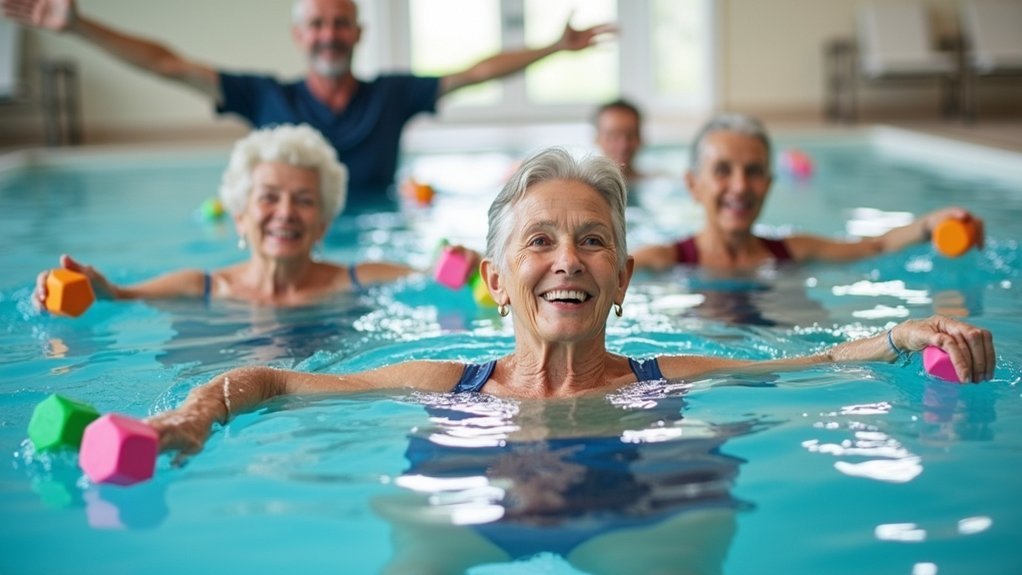
You’ll find remarkable strength gains through graduated depth training, where exercises begin in deeper water and progress to shallower areas as your abilities improve.
Water resistance progressions offer natural opposition that increases as you move faster or use more surface area during movements.
These techniques provide customizable resistance that adapts to your current abilities while supporting your joints, making strength building both safer and more effective for managing Parkinson’s symptoms. The reduced gravity effect in water significantly minimizes the risk of falls during exercise, allowing for more confident movement exploration.
Graduated Depth Training
Graduated depth training offers three key benefits for Parkinson’s patients seeking to build strength in aquatic environments. By strategically varying water levels, you’ll experience increased buoyancy that reduces joint impact while simultaneously challenging your body in a controlled manner.
As you progress from shallow to deeper water, you’ll benefit from:
- Enhanced buoyancy for joint protection and comfort
- Progressive resistance that strengthens muscles gradually
- Improved proprioception and body awareness
- Increased confidence as movements become more natural
The warm, therapeutic environment helps reduce muscle tone and pain, making exercises more comfortable to perform.
This approach allows you to safely challenge your balance as the depth changes, while the water’s natural resistance improves your motor control by providing constant sensory feedback during multidirectional movements.
Water Resistance Progressions
While graduated depth training harnesses water’s variable buoyancy, resistance progression techniques amplify its strength-building potential.
You’ll find that water naturally provides resistance from all directions, engaging multiple muscle groups simultaneously without straining your joints.
Start with simple water walking or jogging exercises, then gradually incorporate gentle resistance tools like water dumbbells or rowing bars.
These tools enhance strength training without the heavy weights that might challenge your balance on land. As you progress, try customizable swim currents that can be adjusted to match your increasing abilities.
The beauty of water resistance is its adaptability—you can increase movement complexity when you’re ready, challenging your coordination while improving cardiovascular fitness.
This progressive approach helps reduce muscle fatigue while engaging your core, ultimately enhancing both strength and proprioception. The low-impact exercises in aquatic therapy are particularly beneficial for Parkinson’s patients who may struggle with conventional land-based workouts.
Group Aquatic Classes: Social Connection Through Movement
For individuals living with Parkinson’s disease, group aquatic classes offer far more than physical benefits—they provide an essential social lifeline.
You’ll experience reduced isolation and depression while building meaningful connections with others who understand your journey.
These supportive environments deliver multiple benefits that enhance your overall wellbeing:
- Increased motivation and consistent attendance through group accountability
- Stress reduction that directly helps manage Parkinson’s symptoms
- Opportunity to form lasting friendships through shared experiences
- Enhanced emotional balance and confidence building through collective achievement
The small class sizes guarantee you receive personalized attention while enjoying the comfort of warm water.
Beyond physical therapy, these sessions become a community where you’ll find understanding, encouragement, and joy—transforming exercise into a social experience that nourishes both body and spirit.
Managing Fatigue and Energy Conservation in the Pool
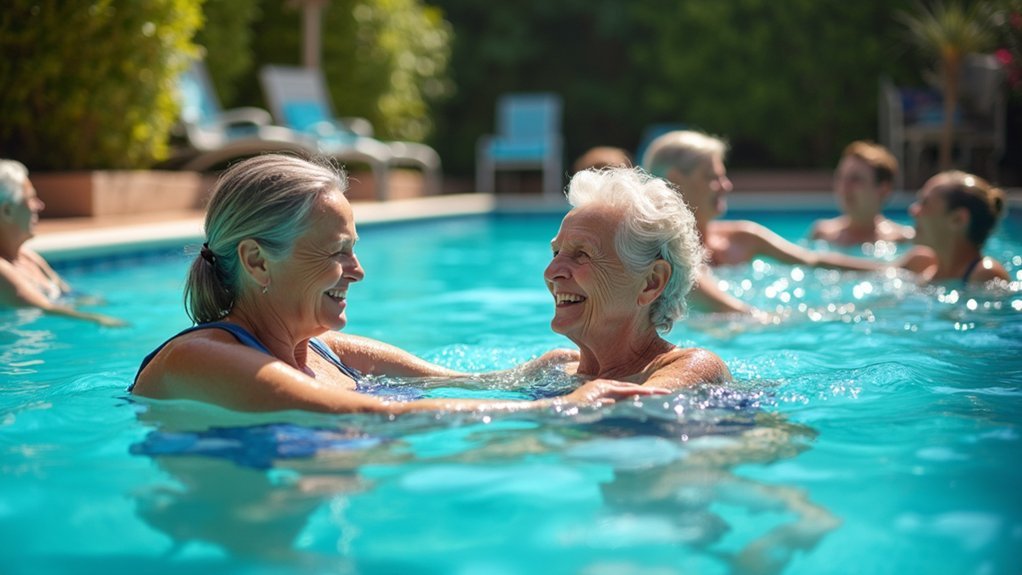
The gentle embrace of water provides a unique sanctuary where Parkinson’s patients can exercise effectively while managing fatigue—a persistent challenge that often limits physical activity. Water’s buoyancy reduces your body’s effective weight, allowing movement with less effort than land-based exercises.
| Energy Conservation Strategy | Benefit | Implementation |
|---|---|---|
| Buoyancy utilization | Reduced joint stress | Use deeper water for difficult movements |
| Warm water therapy | Decreased muscle stiffness | Maintain pool temperature at 83-88°F |
| Interval training | Prevents overwhelming fatigue | Alternate between activity and rest |
| Mindful breathing | Enhances relaxation response | Synchronize breath with movements |
| Flotation devices | Offloads body weight | Use noodles or belts during challenging exercises |
You’ll likely experience lower perceived exertion in water, enabling longer workout sessions without excessive fatigue.
Tracking Progress: Measuring Improvements in Aquatic Settings
You’ll want to track your progress in aquatic therapy using specific milestone assessments like the PDQ-39 quality of life scale and measurements of gait speed and stride length.
Monitor functional improvements such as your ability to maintain balance during increasingly complex water exercises and reduced frequency of freezing episodes.
These measurable indicators help you and your healthcare provider adjust your water exercise program for ideal symptom management and progressive gains in mobility and independence.
Milestone Assessment Techniques
Tracking patient progress in aquatic therapy requires systematic measurement approaches tailored to Parkinson’s disease symptoms. Regular assessment sessions before and after your aquatic intervention will help document meaningful improvements and guide necessary program adjustments.
For extensive milestone tracking, incorporate these evidence-based assessment tools:
- Berg Balance Scale to quantify balance improvements in standardized conditions
- PDQ-39 questionnaire to measure quality of life changes
- UPDRS sections II and III to evaluate motor function progression
- Visual progress charts to maintain motivation and demonstrate improvements
Document both objective measurements and your subjective experiences. When you communicate discomfort, fatigue, or pain during sessions, your therapist can make appropriate modifications.
This collaborative approach guarantees your aquatic therapy program evolves with your changing needs while maximizing therapeutic benefits through every stage of Parkinson’s disease.
Functional Improvement Indicators
Recognizing functional improvements in aquatic settings helps both patients and therapists determine the effectiveness of water-based exercises.
You’ll notice enhanced balance and reduced fall risk due to water’s buoyancy, often surpassing land-based therapy results.
Track your progress through measurable indicators: increased gait speed, improved stride length, and better postural stability.
The warm water’s effect on muscle stiffness will become evident as your movements become smoother and more natural.
You’ll experience greater mobility range and enhanced coordination while feeling secure in the low-impact environment.
Beyond physical markers, monitor quality of life improvements.
Many patients report reduced anxiety, better mood, and increased social engagement.
These psychological benefits complement the physical gains, creating a thorough improvement profile that validates your continued participation in aquatic therapy.
Group participants often find that the social interaction element helps combat isolation while providing peer motivation and encouragement.
Overcoming Common Barriers to Aquatic Exercise Participation
Despite the numerous benefits of water-based exercises for Parkinson’s patients, several common barriers can prevent individuals from participating in aquatic therapy programs. Understanding these obstacles is the first step toward overcoming them.
You’ll find that many barriers are manageable with proper support and planning. Safety concerns like fear of falling can be addressed through specialized equipment and qualified instructors who understand Parkinson’s challenges.
Key strategies to overcome participation barriers include:
- Using grab bars and float supports to increase safety and confidence
- Joining programs with experienced instructors who can adapt exercises to your abilities
- Participating in group sessions to build social connections and motivation
- Discussing transportation options with local support groups or therapy centers
Remember that water’s buoyancy creates a supportive environment where you can move more freely with reduced fall risk.
Integrating Pool Therapy With Daily Movement Strategies
The benefits of water exercises extend far beyond the pool environment for Parkinson’s patients.
When you combine aquatic therapy with your land-based routines, you’ll create a thorough approach to managing your symptoms.
You can gradually shift movements learned in water to everyday activities, improving your balance, posture, and coordination. The confidence gained during pool sessions, where falling risks are minimized, often translates to increased mobility on land.
For best results, maintain consistency in both environments. Work with your physical therapist to design a program that includes 45-60 minute water sessions several times weekly, complemented by specific land exercises.
Regular assessments will help track your progress and adjust strategies accordingly, ensuring you’re maximizing benefits in all aspects of daily movement.
Frequently Asked Questions
How Does Chlorine Affect Parkinson’s Medication Absorption?
Chlorine doesn’t directly affect your Parkinson’s medication absorption. However, it might interact with metabolic pathways and create oxidative stress, potentially altering drug efficacy in your brain. Research on this specific interaction remains limited.
Can Aquatic Therapy Help With Freezing Episodes?
Yes, aquatic therapy can help reduce your freezing episodes. Obstacle aquatic therapy has shown particular effectiveness, improving gait and mobility through low-impact exercises that enhance your balance and muscle control over time.
Is Aquatic Therapy Covered by Insurance for Parkinson’s Patients?
Yes, your insurance may cover aquatic therapy for Parkinson’s if it’s medically necessary. Medicare Part B often covers it when prescribed by your doctor and provided by a Medicare-registered skilled therapist.
What Water Temperature Is Optimal for Parkinson’s Symptoms?
You’ll find ideal relief from Parkinson’s symptoms in water between 90°F to 95°F (32.2°C to 35°C). This warm temperature helps reduce your stiffness and pain while enhancing mobility during therapy sessions.
How Often Should Parkinson’s Patients Attend Aquatic Therapy Sessions?
You should attend aquatic therapy at least twice weekly for 30-60 minutes per session, with a minimum 12-week program for ideal results. If you’re in rehabilitation, you’ll benefit from three to five sessions weekly.
In Summary
You’ve now explored how water therapy can transform your Parkinson’s journey. Don’t wait to plunge into—the buoyancy, warmth, and resistance of aquatic environments will help you reclaim mobility and confidence. Start small, track your progress, and you’ll soon notice improvements in strength, balance, and daily functioning. Remember, you’re not just exercising in water—you’re creating ripples of positive change throughout your life.

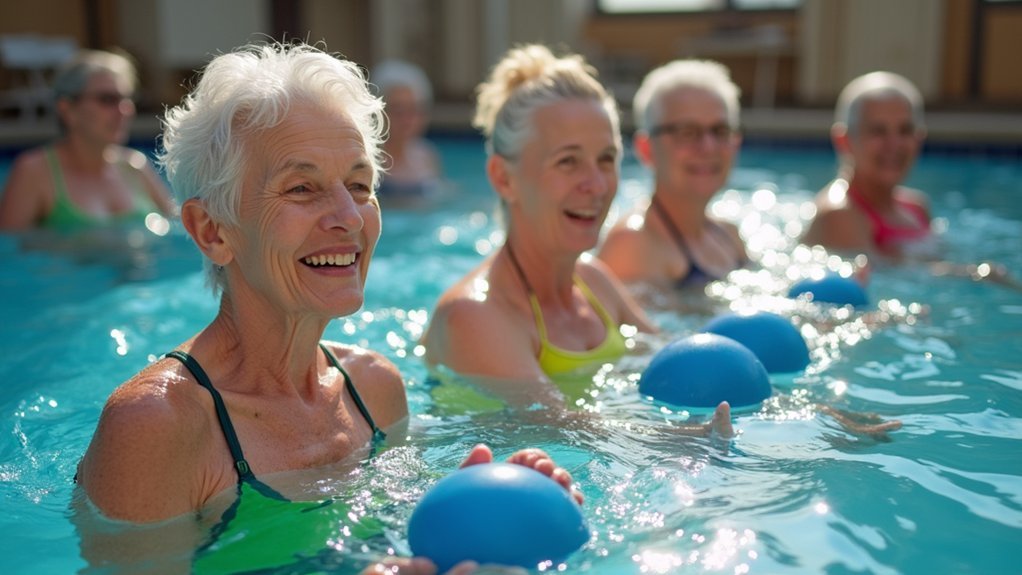



Leave a Reply